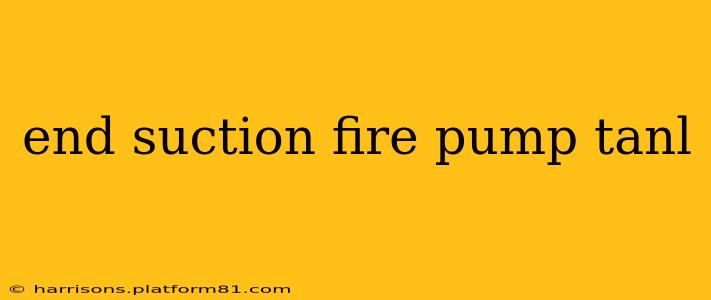End suction fire pumps are critical components of fire protection systems, drawing water from a tank and delivering it under pressure to fight fires. Selecting the right tank and ensuring proper installation are crucial for optimal performance and safety. This comprehensive guide will explore the key aspects of end suction fire pump tanks, addressing common questions and providing valuable insights for engineers, installers, and anyone involved in fire protection systems.
What is an End Suction Fire Pump Tank?
An end suction fire pump tank is a reservoir that supplies water to an end suction fire pump. These pumps, characterized by their suction inlet located at the end of the pump casing, are widely used in fire suppression systems due to their reliability and efficiency. The tank's primary role is to provide a consistent water supply, maintaining sufficient pressure for effective fire fighting. The tank size and material are chosen based on the pump's capacity, the fire protection system's demands, and local fire codes. Common tank materials include steel, fiberglass, and concrete, each offering different advantages in terms of durability, cost, and corrosion resistance.
What are the Different Types of Tanks Used with End Suction Fire Pumps?
Several tank types can be paired with end suction fire pumps, each designed for specific applications and needs:
-
Elevated Tanks: These tanks are positioned above ground, often on a tower, utilizing gravity to maintain water pressure. They offer a reliable, consistent pressure source, especially useful in areas with fluctuating water pressure from municipal supplies.
-
Ground-Level Tanks: These tanks are installed underground or at ground level, often requiring a pump to deliver water to the end suction fire pump. They typically need a booster pump to augment pressure. This approach is common where space for elevated tanks is limited.
-
Pressure Tanks: These tanks are pressurized to maintain a consistent water supply and pressure. They are often smaller than elevated or ground-level tanks but provide a readily available water source for immediate response.
What Size Tank Do I Need for My End Suction Fire Pump?
Determining the appropriate tank size for your end suction fire pump is critical. The necessary capacity depends on several factors, including:
-
Fire Protection System Requirements: Local fire codes and the specific needs of the protected building or area will dictate the minimum water volume required.
-
Pump Capacity: The pump's flow rate and pressure capabilities influence the required tank size. A higher capacity pump generally requires a larger tank to maintain adequate water supply.
-
Demand Duration: The anticipated duration of fire fighting operations plays a significant role. Larger tanks are needed to support longer firefighting efforts.
A qualified fire protection engineer can perform the necessary calculations and determine the optimal tank size based on these factors.
How Much Does an End Suction Fire Pump Tank Cost?
The cost of an end suction fire pump tank varies considerably based on several factors:
-
Tank Size: Larger tanks naturally cost more due to increased material and construction requirements.
-
Tank Material: Steel tanks are generally more affordable than fiberglass or concrete, but the latter may offer longer lifespans in certain environments.
-
Installation Costs: The cost of installation, including site preparation, delivery, and labor, significantly impacts the overall expenditure.
Obtaining quotes from multiple tank suppliers and contractors is recommended to compare costs and ensure you receive a competitive price.
How is an End Suction Fire Pump Tank Installed?
Installing an end suction fire pump tank involves several critical steps, including:
-
Site Preparation: Ensuring a level and stable base is crucial, especially for ground-level tanks.
-
Tank Placement: Careful positioning is necessary to optimize accessibility for maintenance and ensure proper connections to the pump and piping system.
-
Piping Connections: Correctly connecting the tank to the pump, valves, and other components of the fire protection system is crucial for reliable operation.
-
Testing and Commissioning: Thorough testing is essential to verify the system's functionality and ensure it meets the required performance standards. Professional installation by a licensed contractor is strongly recommended.
What are the Maintenance Requirements for End Suction Fire Pump Tanks?
Regular maintenance is vital to ensure the tank's longevity and the fire protection system's readiness. This includes:
-
Regular Inspections: Visual inspections should be performed periodically to detect any signs of corrosion, damage, or leaks.
-
Cleaning and Flushing: The tank should be cleaned and flushed regularly to remove sediment and prevent contamination.
-
Pressure Testing: Periodic pressure testing is crucial to ensure the tank's integrity and ability to withstand the required pressure.
Following a preventative maintenance schedule will help extend the tank's lifespan and ensure the reliability of your fire protection system.
This comprehensive guide provides a solid foundation for understanding end suction fire pump tanks. Remember that professional consultation with fire protection engineers and licensed contractors is essential to ensure the safe and effective implementation of your fire suppression system. Always adhere to local building codes and regulations.
